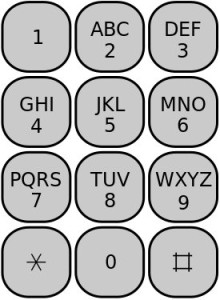Two ways of converting words to numbers are pointed out in the Method page (para 8 and 14). In this post, I’m showing three more ways of doing it.
First, we can use the telephone keypad configuration which has the numbers 2 – 9 associated with letters of the alphabet as shown:

For example, “honesty” will be represented by 4663789.
The easy availability makes this a very convenient way. One shortcoming is the non-occurrence of ‘0’ and ‘1’ in the numbers. However, this may be turned into an advantage. Insert them into the numbers to serve as red herrings.
The second way is the system used in mnemonics (memory techniques) to remember numbers. The phonetic number system uses consonant sounds to represent the ten digits as follows:
| Number | Consonant Sounds | Memory Aid |
| 0 | s, z, soft c | zero starts with a Z |
| 1 | t, d, th | a t has 1 down stroke |
| 2 | n | an n has 2 legs |
| 3 | m | an m has 3 legs |
| 4 | r | r is the 4th letter of four |
| 5 | l | the 5 fingers of the hand make an L |
| 6 | j, ch, sh, soft g | a script j has a lower loop like 6 |
| 7 | k, q, hard c, hard g, ck | k looks like two horizontal 7’s |
| 8 | f, v, ph | a cursive f looks like a figure 8 |
| 9 | p, b | p is a mirror image of 9 |
W, h, y and the vowels have no value. They are, however, needed for words to be made. ‘h’ modifies the values of ‘c’, ‘s’, and ‘p’ if it comes immediately after these letters.
In mnemonics, numbers are converted to words and a memorable story or sentence is made up containing those words. The story/sentence will help the words to be recalled and thus the number they represent. In applying this system, the pronunciations and the sounds are what determine the values and not just the letters per se. Hence there are rules concerning silent letters, double letters and on dealing with the letter ‘x’ due to peculiarity of pronunciations. For a better idea, please see http://www.memorizeeverything.com/core_skills/numbers/
The advantage of using this method, sometimes referred to as the major system, is that there is no counting involved. When we look at the word, the number it represents will come to mind immediately. Some amount of practice is required. What it requires is a good understanding of English pronunciations.
The third method I am introducing is an adaption of the phonetic system to help those who have difficulty with English pronunciations. Instead of sounds, we can devise a system based on the shapes of the numerical digits and the alphabets. Here is an example:
| Number | Consonant | Memory Aid |
| 0 | z, r | zero contains these 2 consonants |
| 1 | l | it looks like 1 |
| 2 | n, h, v | these letters have 2 legs/horns |
| 3 | m, w | they are 3 lying on its sides |
| 4 | x, y | 4 has lines that cross |
| 5 | s | round up the kinks and 5 looks like s |
| 6 | c, j | c curls in the same way as 6, while j is a mirror image |
| 7 | k, t | k looks like two horizontal 7’s & script capital T looks like 7 |
| 8 | f | a cursive f looks like a figure 8 |
| 9 | g, b, d, p, q | 9 looks like g and we put all the lollipops here. |
Here, all the consonants have values. Vowels again have no value.
Some examples:
Carpenter is converted to 609270
Computer 63970
Telephone 71922
Football 87911
Chrysanthemum 6204527233
Wonderfulday 32908194
Dancing 92629
Positive 957
You can see that it is quite easy to get a hang of it and the number comes very quickly. This adaptation also suggests that we can create our own codes. If you assign a different value to some of the letters, and it is quite easy to rationalize for them, you would have your own unique code. Any variation will raise the odds against hackers and this will indirectly make the system stronger for everybody because the hacking program will have to deal with additional factors.
